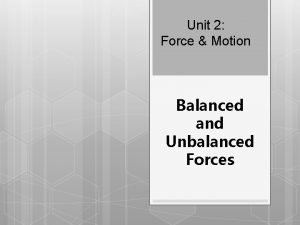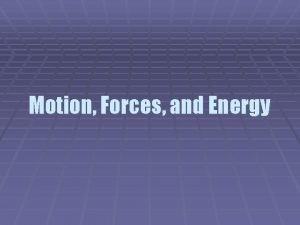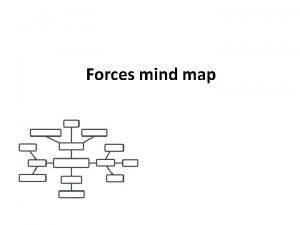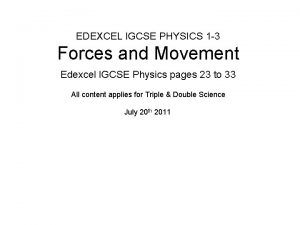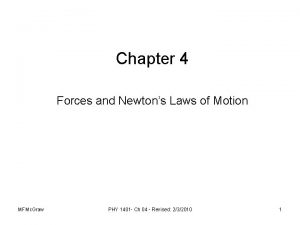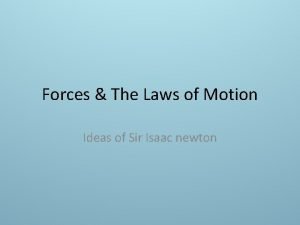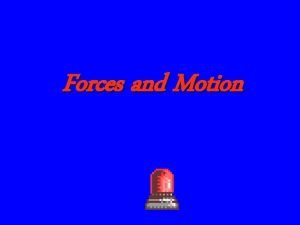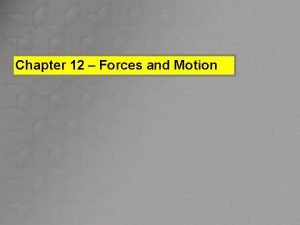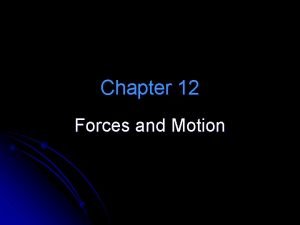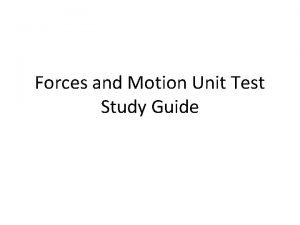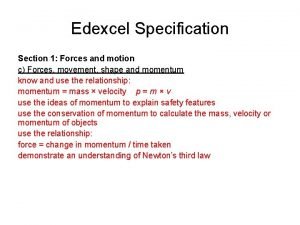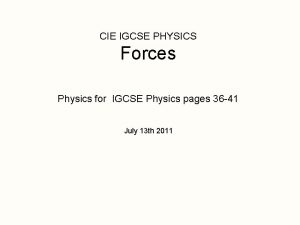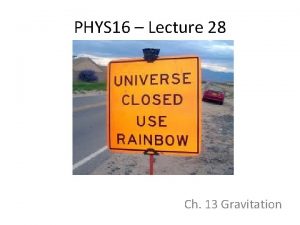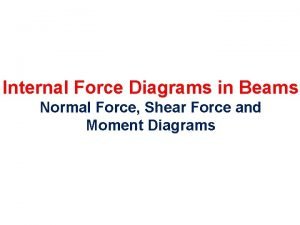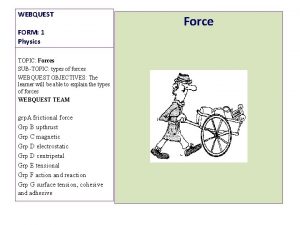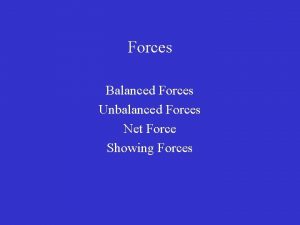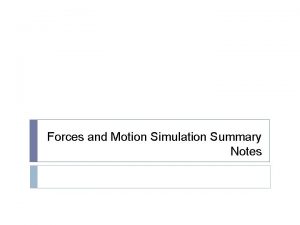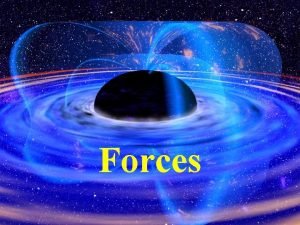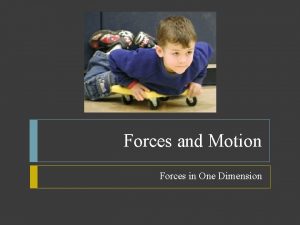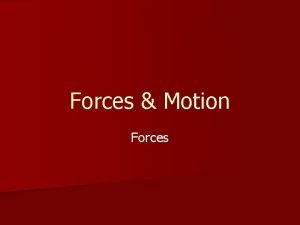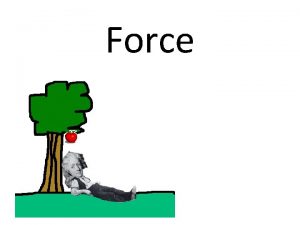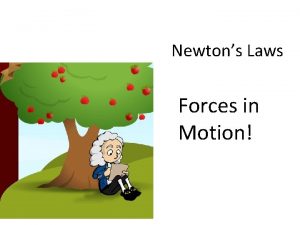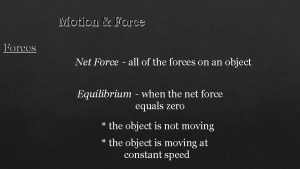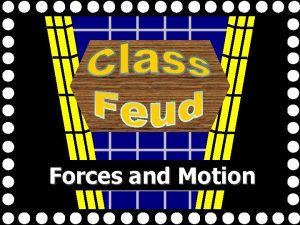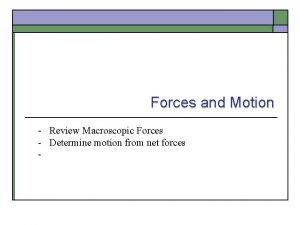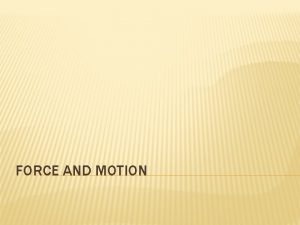Force Motion Forces and Motion 7 P 1






























- Slides: 30

Force & Motion

Forces and Motion 7. P. 1 Understand motion, the effects of forces on motion and the graphical representations of motion. 7. P. 1. 1 Explain how the motion of an object can be described by its position, direction of motion, and speed with respect to some other object. 7. P. 1. 2 Explain the effects of balanced and unbalanced forces acting on an object (including friction, gravity and magnets). 7. P. 1. 3 Illustrate the motion of an object using a graph to show a change in position over a period of time. 7. P. 1. 4 Interpret distance versus time graphs for constant speed and variable motion.

Location, location How can you describe the location of an object? • Positiondescribes the location of an object. • Comparisons using known objects or locations often are used to describe position. • A reference pointis a location to which you compare other locations.


How is distance measured? • Distance can be measured as a straight line between two positions. • Distance can also be measured as the total length of a certain path between two positions. • The standard unit of length for distance is the meter (m).

What is speed? • Speed is a measure of how far something moves in a given amount of time. • Speed measures how quickly or slowly an object changes its position. • Fast objects move farther than slower objects in the same amount of time.

What is average speed? • Average speed is a way to calculate the speed of an object that may not always be moving at a constant speed. • Average speed describes the speed over a stretch of time rather than at any exact moment in time.

Speed It Up! How is average speed calculated? • Speed can be calculated by dividing the distance an object travels by the time it takes to cover that distance. • speed = distance/time • s = d/t

How is average speed calculated? • If two objects travel the same distance, the object that takes less time has the greater speed. • An object with a greater speed travels farther in the same time than an object with a lower speed travels. • The standard unit for speed is meters per second (m/s).


How is constant speed graphed? • The slope, or steepness, of the line is equal to the average speed of the object. • Average speed can be calculated by dividing the change in distance by the change in time for that time interval. • slope = change in y/change in x

How are changing speeds graphed? • On a distance-line graph, a change in the slope of a line indicates a change in speed. • If the line gets steeper, the object’s speed has increased. • If the line gets less steep, the object has slowed down. • A flat line indicates zero speed.



What is velocity? • Average velocity depends on the distance from the starting point to the final point. • Average velocity can be 0 km/h if you travel at a certain speed to one point and then travel back to the starting point.


What is a force, and how does it act on an object? • Forces can act on objects that are in contact with each other. Such a force is called a contact force. • Friction is an example of a contact force between two surfaces that are touching. • Car tires rely on friction to keep a moving car from sliding off a road. Cars may slide on icy roads because ice lowers the force of friction on the tires.

What is a force, and how does it act on an object? • Forces can also act on objects that are at a distance. • Gravity is a force that pulls objects toward Earth. • Magnetic forces can also act at a distance. Magnetic force can be a pull, as when a magnet holds paper to a metal refrigerator door, or a push, as when like poles of two magnets push each other apart.

In the Balance What happens when multiple forces act on an object? • The net forceis the combination of all the forces acting on an object. • When forces act in the same direction, they are added to determine net force. • When forces act in opposite directions, the smaller force is subtracted from the larger force.

What happens when multiple forces act on an object? • A net force of zero means the forces are balanced and will not cause a change in motion. • Unbalanced forces produce a change in an object’s motion. The object could change speed, direction, or both. This change in motion is called an acceleration. • Acceleration is always in the direction of the net force.

It’s the Law What is Newton’s First Law of Motion? • Sir Isaac Newton described three laws of motion that explain the relationship between force and motion. • Newton’s first law describes the motion of an object that has a net force of 0 N acting on it. • The law states: An object at rest stays at rest, and an object in motion stays in motion at the same speed and direction, unless it experiences an unbalanced force.

What is Newton’s First Law of Motion? • Newton’s first law is also called the law of inertia. • Inertiais the tendency of all objects to resist any change in motion. • The law of inertia explains why a chair will not slide across the floor unless a force pushes the chair, and why a golf ball will not leave the tee until a force pushes it off.


What is Newton’s Second Law of Motion? • Newton’s second law states: The acceleration of an object depends on the mass of the object and the amount of force applied. • force = mass × acceleration (F = ma)

Newton’s Second Law and You • Have you ever been on a roller coaster? Did you feel like you were going to float out of your seat when you went over a big hill? • When a roller coaster is going up a hill, there are two important forces acting on you: the force of gravity and the upward force exerted by the roller coaster seat. • Once the roller coaster starts down the other side of the hill, it accelerates downward, and your seat does not support your full weight.

Newton’s Second Law and You • The airplane’s path looks like a roller coaster hill. As the plane accelerates downward, the passengers lose contact with the plane and fall toward Earth. This condition is called free fall.


It’s the Law What is Newton’s Third Law of Motion? • Newton’s third law states: Whenever one object exerts a force on a second object, the second object exerts an equal and opposite force on the first. • In other words, all forces act in pairs. • Action and reaction forces are present even when there is no motion.

What is Newton’s Third Law of Motion? • Even though action and reaction forces are equal in size, their effects are different. • An object can have multiple forces acting on it at once. When this happens, each force is part of a force pair.

 Parallel forces examples
Parallel forces examples Contact vs noncontact forces
Contact vs noncontact forces Net force
Net force Is erosion a constructive force
Is erosion a constructive force Vector free body diagram
Vector free body diagram The forces shown above are pushing/pulling forces
The forces shown above are pushing/pulling forces Intermolecular forces vs intramolecular forces
Intermolecular forces vs intramolecular forces Intra vs intermolecular
Intra vs intermolecular Intermolecular force of attraction
Intermolecular force of attraction Unbalanced force example
Unbalanced force example Motion forces and energy
Motion forces and energy Forces mind map
Forces mind map Edexcel igcse physics movement and position questions
Edexcel igcse physics movement and position questions Force and motion summary
Force and motion summary Section 3 motion and forces worksheet answers
Section 3 motion and forces worksheet answers Derek leaves his physics book on top of a drafting table
Derek leaves his physics book on top of a drafting table Newton's laws jeopardy
Newton's laws jeopardy Chapter 12 forces and motion
Chapter 12 forces and motion Chapter 12 forces and motion
Chapter 12 forces and motion Chapter 9 motion and energy answer key
Chapter 9 motion and energy answer key Energy and forces unit test
Energy and forces unit test Study jams forces and motion
Study jams forces and motion Section 1 forces and motion answers
Section 1 forces and motion answers Force igcse
Force igcse Balanced force examples
Balanced force examples Centripetal force and gravitational force
Centripetal force and gravitational force Normal force and gravitational force
Normal force and gravitational force Internal normal force diagram
Internal normal force diagram Which of the following forces is a contact force? *
Which of the following forces is a contact force? * Forces webquest
Forces webquest Aristotle and galileo views of motion venn diagram
Aristotle and galileo views of motion venn diagram









